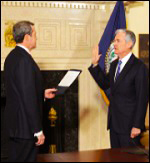By Pam Martens and Russ Martens: November 23, 2021 ~

Jerome Powell Sworn in as Fed Chair, February 5, 2018, by Vice Chair for Supervision, Randal Quarles
Fed Chair Jerome Powell now finds himself in the same position as Morgan Stanley’s Howie Hubler and JPMorgan’s Bruno Iksil: he’s got a big trade on and no exit plan. The problem for the U.S. economy is this: Hubler and Iksil were gambling with billions of dollars. Powell is gambling with trillions of dollars. Powell’s Fed has effectively become the Whale in the U.S. debt market.
Powell was last sworn in as Fed Chair on February 5, 2018. Five days earlier, the securities held on the Fed’s balance sheet totaled $4.2 trillion. As of last Wednesday, that figure stood at $8.179 trillion, thanks to Powell’s endless purchases of U.S. Treasury securities and agency mortgage-backed securities (MBS). Making this situation even more dicey, the Fed bought these debt securities with money it creates out of thin air. The U.S. taxpayer is on the hook for 98 percent of the Fed’s balance sheet.
Powell likes to tell reporters at his press conferences that the Fed has only “lending powers and not spending powers.” Powell says this to appease academics and critics who believe he is violating the Federal Reserve Act by becoming the buyer-of-last-resort for Wall Street’s excesses instead of sticking to the Fed’s role as lender-of-last-resort to the banking system.
The Federal Reserve had been around for 95 years when the 2008 financial crisis struck. In all that time, the Fed had never engaged in buying up toxic assets from Wall Street. It understood that the Federal Reserve Act restricted its activity to being a lender-of-last-resort. But this is how the government audit of the Federal Reserve by the Government Accountability Office in 2011 described the Fed’s “purchases” of toxic assets from Wall Street during the 2008 financial crisis:
“Maiden Lane (Mar. 16, 2008) Special purpose vehicle created to purchase approximately $30 billion of Bear Stearns’s mortgage-related assets.”
“Maiden Lane II (Nov. 10, 2008) Special purpose vehicle created to purchase RMBS [Residential Mortgage Backed Securities] from securities lending portfolio of AIG subsidiaries.” Peak amount outstanding $20 billion.
“Maiden Lane III (Nov. 10, 2008) Special purpose vehicle created to purchase collateralized debt obligations on which AIG Financial Products had written credit default swaps.” Peak amount outstanding $24 billion.
“CPFF – Commercial Paper Funding Facility (Oct. 7, 2008–Feb. 1, 2010) Provided loans to a special purpose vehicle to finance purchases of new issues of asset-backed commercial paper and unsecured commercial paper from eligible issuers.” Peak amount outstanding $348 billion.
Last year, the Fed rolled out many of the same emergency lending facilities it had used during the 2008 crash and its aftermath.
Prior to the 2008 financial crisis, the Fed’s balance sheet stood at $929 billion as of December 26, 2007. After the 2008 crisis, the Fed’s balance sheet peaked at $4.5 trillion in 2015. The Fed promised to “normalize” its balance sheet. But instead of materially reducing its bond holdings, the Fed’s balance sheet has now skyrocketed to $8.7 trillion as of last Wednesday.
The Fed has now stated that it plans to begin tapering its purchases of $120 billion a month in debt securities, a tactic it has used to keep interest rates artificially depressed. Unfortunately, that’s not an exit plan. The Fed effectively has no exit plan to wean Wall Street off its easy money policies without creating massive ruptures in the stock market, leading potentially to more Fed bailouts and an even larger balance sheet at the Fed.
There was a small taste of what’s to come in Powell’s second term as Fed Chair yesterday afternoon.
At 3:12 p.m. yesterday, the reality of Powell’s lack of an exit plan suddenly registered in the minds of traders across Wall Street. The Dow Jones Industrial Average began to plunge after rallying in the morning on the news that President Biden had nominated Powell for another four-year term as Fed Chair.
At 3:12 p.m. the Dow stood at 35,918.33. By the closing bell, it registered 35,619.25, a drop of 299.08 points in 48 minutes. For the full trading day, the Dow gained just 17.27 points. Damage on the tech heavy Nasdaq was far worse. It gave up 202.6 points on the day.
All in all, yesterday was not a vote of confidence in Powell’s stewardship going forward.

